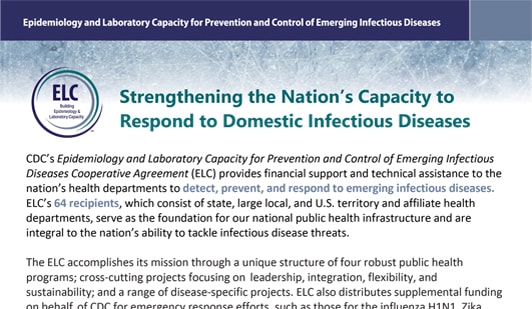ELC Overview
Strengthening the Nation’s Capacity to Respond to Domestic Infectious Diseases
CDC’s Epidemiology and Laboratory Capacity for Prevention and Control of Emerging Infectious Diseases Cooperative Agreement (ELC) provides financial support and technical assistance to the nation’s health departments to detect, prevent, and respond to emerging infectious diseases. ELC’s 64 recipients, which consist of state, large local, and U.S. territory and affiliate health departments, serve as the foundation for our national public health infrastructure and are integral to the nation’s ability to tackle infectious disease threats.
ELC accomplishes its mission through a unique structure of four robust public health programs: cross-cutting projects focusing on leadership, integration, flexibility, and sustainability; and a range of disease-specific projects. ELC also distributes supplemental funding on behalf of CDC for emergency response efforts, such as those for the influenza H1N1, Zika, and Ebola epidemics, and most recently, the COVID-19 pandemic.
Our Structure: What Sets ELC Apart
Flexible funding provides recipients the ability to meet their own changing needs, instead of a one-size-fits-all strategy.

Funding for leadership and management supports strategic planning and management of ELC resources.

Disease-specific projects allow for prioritization of health topics specific to certain areas or populations, such as Legionnaires’ disease or vaccine-preventable diseases.
Cross-cutting projects and programs enhance collaboration between state epidemiology and laboratory, as well as local public health departments.
In 2022, ELC awarded approximately $197M to its 64 recipients in core funding to continue the crucial work of health departments across the United States.
ELC Programs and Projects